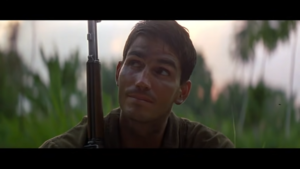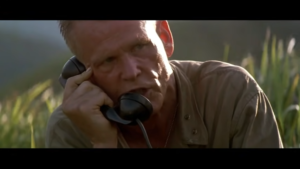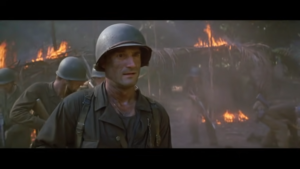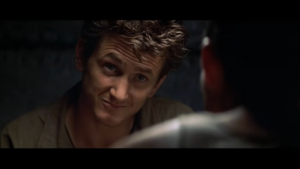Rating: 4 out of 5




There is a quote that resonated from The Thin Red Line that resonated with me while watching this film. During one of the intense scenes, one of the soldier’s monologues while the battle was going on. The soldier spoke, “This great evil. Where did it come from? How did it steal into the world? What seed, what root did it come from? Who’s doin this? Who’s killin’s us? Robbin’ us of life and light. Mockin us with the sight of what we might have known. Does our ruin benefit the earth? Does it help the grass to grow, the sun to shine? Is this darkness in you to?”
When listening and reading the quote above, it makes you think about where did evil in the world come from. How did it appear? How do we as humans keep doing the same thing repeatedly with death and violence towards each other? World War II showed one of the greatest evils of all time in the history of men. The acts that started it to what ultimately finished it. The Thin Red Line shows what soldiers must do to stop that evil from spreading.

Written and directed by Terrence Malick, this version is the second screen adaptation of the 1962 novel of the same name by James Jones. Many consider this as not a remake but a retelling of the book. It explains a fictionalized version of the Battle of Mount Austen. The battle was part of the Guadalcanal Campaign in the Pacific Theater of World War II. It follows soldiers of C Company, 1st Battalion, 27th Infantry Regiment, 25th Infantry Division. In 1942, United States Army Private Witt (Caviezel) goes AWOL from his unit to live among the carefree Melanesian natives in the South Pacific. Witt is later found and imprisoned on a troop carrier by First Sergeant Welsh (Penn) of his company. While Witt is not allowed to rejoin his unit, he is assigned to act as a stretcher-bearer and reinforcements in a campaign to secure Henderson Field and seize the island from the Japanese and block off their route to Australia. The men arrive at a key Japanese position. Their task is to take the hill at all costs. The men see how deadly the war is while trying to take the position in the next few days.
It is a toss-up whether or not you will hate, like, or love this film. I have watched it twice before writing this review to make sure I have a sound thought on my feelings for this film. I personally think this is a high-quality movie. The story is told from flashbacks and perspectives of several soldiers on the battlefield. From one perspective, we have two soldiers who went AWOL and monologued about their views on the war before having to return to the front lines. There is another perspective of a man who thinks about his loving wife and their time before he was shipped off. There is also a Colonel who wants one last major battle to prove himself. These three intertwining stories develop the plot at the fictionalized version of the Battle of Mount Austen, which was part of the Guadalcanal Campaign in the Pacific Theater of World War II.

Now with these intertwining stories, it does become quite confusing of what is actually going on. When I first watched this film, I was confused about the timeline. At first, Caviezel’s character was happy and rowing a boat in some of the bluest water ever. You think that he has time off, but actually, he just bounced, and his narrative made it seem like the war was over, only for him to be picked up again to fight. That is how many of the stories go as the flow of time gets messed up when people have flashbacks to what is going on. It’s nice to know and try to make you care about people, but I feel like the flashbacks get lost when the actual war scenes happen. These perspective moments are scattered throughout the film that somewhat halts the action. I see what the film was going for, but it doesn’t pull it off that well.
Now, with any war movie, you gotta talk about the war scenes. Let me tell you that the war scene in this film is very high quality and excellent. Now the setup of the battle is set up really well. Travolta’s character, a general, is given the order to take an island because the Japanese army has built an airfield, and they need to take it. Nolte’s character, Lt. Col. Gordon Tall, wants to have one last battle to show his worth and actually will stop at nothing to get what he wants and pushes his men to the limits no matter how many are sacrificed. Then other characters think the orders are overboard and want to think of a new strategy. As with war, nothing is ever straightforward.
This sets up a shit show of a battle. When Leto’s character tells his men to move and stand up, it is almost like a massacre. That is what you think the battle is, a straight-up massacre. The war scenes are not as intense or even bloody as Saving Private Ryan, but they show just enough for you to get the idea. People get exploded, you see the hesitation in the men to risk their lives, you see soldiers break the line and attack and the inner conflict of what is asked for them. War is a fucked up place to be, and this movie shows that you will be messed up beyond belief no matter what you do.

One scene that made the war scene crazy was when Leto’s character ordered the attack. When homeboy stood up, along with his men, there was straight-up bloodshed. It was intense and scary at the same time as you knew more death was coming. Another scene was when Harrelson’s character pulled his grenade pin strapped to his belt and made the quick decision to fall on it, saving everyone. I wanted to see blood and guts, but you get a plea from the character stating not to tell his wife he died like a punk. The whole invading the camp scene was a little off as it was like a last big charge and seemed to be in slow motion. It was intense as you finally see the US victory, but you also see the exhaustion in the Japanese men. Oh, and the whole taking over the hill and bunker scene was intense as you didn’t know if the US men would capture it. All these scenes made for a decent war film.
The cinematography in this film is a highlight. At the beginning of the film, the people swim in the clearest and bluest water along with the natives rowing by. Then the shot of the men in the U-Boats sailing to the island as planes fly overhead is something to see. That scene gives you a clear view of the island that the forces are approaching. Also, some of the camera views set the absolute tone. A perfect example of this is when the men are in the grass at the beginning. It is at first dark and then slowly becomes light as the cloud cover goes by. This gives you the feeling that it’s about to go down. Every scene in the battle is shot beautifully with this film.

Now I want to give it up to my boy, Hans Zimmer. When it comes to making music for intense situations, the dude is one of the best in the game. The music in this film is nothing less than outstanding. When it needs to be somber, it has that somber and sad melody. When the action gets intense, the music follows the intensity. One of the strongest parts of this film is the music, and Zimmer knows how to make a scene better with music.
Let’s give a shout-out to Terrence Malick for writing and directing this film. The film marked Malick’s return to filmmaking after a 20-year absence. This was an ambitious project to take on with so much stuff going on. Also, for it to come out the same year as Saving Private Ryan, I give the dude props because that film was a monster of a film. Malick’s direction seemed off sometimes with pacing, but overall, he made a decent war film.
Now, this film had EVERYONE in it, and some you were like, “Damn, you in this film too?” Here is a list of everyone in this film, and many of them die because it is a war film. We have Sean Penn, Adrien Brody, Jim Caviezel, Ben Chaplin, George Clooney, John Cusack, Woody Harrelson, Elias Koteas, Jared Leto, Dash Mihok, Tim Blake Nelson, Nick Nolte, John C. Reilly, Larry Romano, John Savage, John Travolta, and Arie Verveen. Look how many freakin stars there are today. How can you become invested in any one character? The primary person you become invested in is Jim Caviezel as Pvt. Robert E. Lee Witt. He starts the whole film with his monologue, and then his death ends the film as he tries to help his unit. Nick Nolte as Lt. Col. Gordon Tall is also a prominent figure as he is that old war dog who wants one last hoorah. With so many people, it is fun to see if you can name as many people as possible. There are a few that wasn’t mentioned.
The Thin Red Line is a good World War II film, but it had the untimely year of running into an all-time great World War II film in Saving Private Ryan. The film has a good plot, but the storytelling is a tad bit off. The cast is great as there are beyond many people in it. Zimmer’s music is definitely a plus. Watch this movie during one of the major holidays and honor the men who fought and died for our freedom.